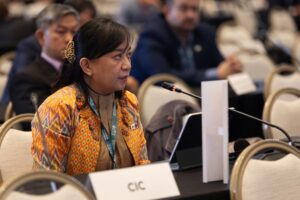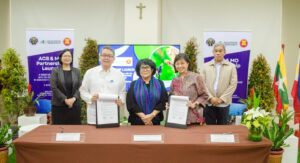Fishing under the tree in Inlay Lake Wildlife Sanctuary, an ASEAN Heritage Park in Myanmar. Photo: Hein Htet for the ACB Zooming in on Biodiversity Photo Contest.
Born and raised in Brajah Harjosari, a village on the borders of Way Kambas National Park, an ASEAN Heritage Park (AHP) in Southern Sumatra, Indonesia, the 44-year-old Pak Agus used to witness countless elephant raids and ravages to their farming community’s crops and properties. This constant dilemma and the safety issues for humans and elephants alike grew into an ill-fated relationship between them; not to mention that the severe impacts of these raids on the villagers’ livelihoods have forced many of them to enter the park to find food.
In 2022, Pak Agus and other village members became beneficiaries of the Small Grants Programme (SGP) by the ASEAN Centre for Biodiversity (ACB) that provided them with an alternative source of income through the group POKDARWIS Braja Harjosari. The group offers a tour package inclusive of homestays, birdwatching, night safari tours, selling of souvenir items, and transportation services for local visitors and tourists that see the wildlife, especially elephants at Way Kambas up close. From seeing these gentle giants as competitors for resources, the villagers now see them as their biggest allies in providing a sustainable source of income for their families.
Pak Agus is just one of the many faces of AHPs—natural sanctuaries in the ASEAN region that demonstrate that a life in harmony with nature is possible.
On this day, we commemorate the founding of the AHP Programme – a flagship initiative of ASEAN recognising protected areas of high conservation importance that serve as habitats to the region’s unique and diverse web of life. For 39 years, the AHP programme has been steadfast in supporting the conservation and sustainable management of remaining important ecosystems in the region. The ACB serves as the secretariat of the AHP Programme.
The AHP has grown into a dynamic network of 57 globally important parks and nature reserves composed of more than 11 million hectares of protected areas, where 2.5 million hectares are marine and inland waters while 8.5 million hectares are terrestrial.
These “cream of the crop protected areas” continue to generate greater awareness, pride, appreciation, enjoyment, and conservation of ASEAN’s biodiversity, and inspire collaboration among the ASEAN Member States in preserving their shared natural and cultural heritage. Well-managed AHPs have also been crucial in making the region more resilient to natural disasters and in regulating the spread of zoonotic diseases.
The AHP Programme is not just a recognition scheme—the declaration of an AHP also marks the beginning of a wealth of opportunities in store for these model protected areas. Being an AHP provides opportunities to: exchange knowledge and best protected area management practices with other AHPs; have access to capacity development opportunities; engage with potential conservation partners; be part of technical exchange and research programmes; and get assistance in enhancing management operations. Additionally, the ACB continues to boost the promotion of the AHPs as prime ecotourism sites and as areas of high conservation importance through the Centre’s communication, education, and public awareness programmes.
Collaborative management
Over the course of the AHP Programme’s nearly four decades of existence, collaborative management has been essential to its successful implementation. AHP management planning involves not just the park management officials but also the local communities, the private sector, and relevant stakeholders such as indigenous people, women, and the youth, among others. Continued cooperation within and among the AHPs along with the communities, local and national governments, as well as institutional partners contributed significantly in effectively managing the AHPs—demonstrating that a whole-of-community approach is a viable and sustainable strategy in biodiversity conservation.
Conservation and livelihood improvement: striking the balance
To ensure the participation of stakeholders in the conservation of AHPs, we help them ensure that their fundamental needs are met. Hence, a lot of our interventions in the AHPs involve providing local communities with sustainable livelihood opportunities while encouraging them to conserve and protect the biological resources of the parks or nature reserves.
The SGP for example—a joint initiative with the Federal Government of Germany through the KfW Development Bank has been providing financial grants to local communities within and around the AHPs to support livelihood and conservation projects in select sites in Indonesia, Myanmar, and Viet Nam amounting to roughly EUR 17 million. These projects were carefully selected according to the existing challenges, needs, and biodiversity status of the sites, following stringent selection processes.
Just this year, 75 grant projects in Indonesia have been successfully concluded, which benefited 33 grantee organisations and 42 micrograntees and achieved (1) significant wildlife and biodiversity survey data particularly on key species such as the Sumatran elephant, Sumatran rhino, and Sumatran tiger; (2) ecosystem restoration activities combined with livelihood programmes to tackle human-wildlife conflict and tenurial conflict; and (3) integrated ecotourism development as part of livelihood improvement.
Another ACB intervention in AHPs was the Biodiversity-Based Products (BBP) as an Economic Source for the Improvement of Livelihoods and Biodiversity Protection project implemented in Cambodia, Lao PDR, and Viet Nam. Concluded in 2019, these pilot projects enabled an increase in the income of the rural communities living within and around AHPs, while ensuring sustainable use and practices in the utilisation of biological resources that were turned into commercial products.
This initiative not only increased household income of local communities from 70% to 140%, but also encouraged more active community participation in protecting the national parks.
Despite all these successes, the AHP programme still needs to intensify its partnerships within the network and with other organisations to further expand the scope of protected area coverage in the region and ensure the effective management of these conservation areas.
Moving forward, we encourage more coastal and marine protected areas, urban wetlands, and transboundary protected areas to be part of this strong network of AHPs as we boost our efforts to have a more diverse ecosystem representation contributing to the achievement of global biodiversity targets or the Kunming-Montreal Global Biodiversity Framework. Additionally, AHPs need more robust and sustainable financing as these protected areas play a crucial role in promoting nature-based solutions to the triple planetary crises—pollution, climate change, and biodiversity loss.
























